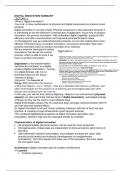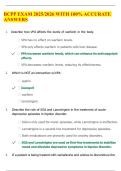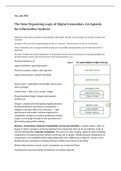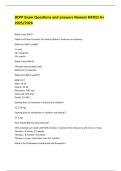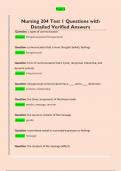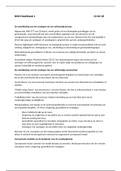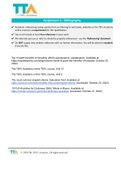Communications and networking
Chapter 1 – Introduction
Network – consists of a number of interconnected, autonomous computers.
- All computers have their own operating system and can act independently.
being interconnected means that the computers can send information to each other.
Distributed systems – consist of many processors linked together but acting as one
computer under the control of one copy of the operating system.
Local area networks (LANs)
- Limited to small geographical area.
- Data transfer rates tend to be very high.
- Usually owned by one organisation
Wide area networks (WANs)
- Connect computers over long distances
- Data rates are typically lower than those of LANs
- Normally used to interconnect LANs
- Uncommon to be owned by one organisation.
Metropolitan area network (MAN)
- Halfway house between LANs and WANs
- Can span an entire city and their suburbs
- Reach is not as great as that of WANs
Personal area networks (PANs) & Home area networks (HANs) short-range networks.
Reasons for networks
LANs share computer hardware, software applications and data files. Communications
such as e-mail or instant messaging.
WANs added advantage of a world-wide reach.
Source – sending computer
Medium – along which the data travels – often, but not always, a cable
Destination – receiving computer
The source, destination and any other devices on the network all use the same protocol
set of rules to make communication via a network satisfactorily.
Data is usually sent in a packet. The packet will contain addressing information, will also
contain other items that are needed to facilitate communication.
Chapter 2 – Communications Technologies
Data is often moved around on parallel pathways. Parallel transfer is used inside the
processor. Outside the processor a parallel bus is often used.
Peripheral component interconnect (PCI) bus: 64 wires can be used to transfer data
between components.
Parallel transfer is not always used. A serial advanced technology attachment cable may be
used to attach a hard disk drive to its controller.
Serial connections are used for external connections.
In serial transfer, only one wire carries the data, and only one bit it transmitted at a time.
,Vital piece of hardware for communication over a network = network interface card (NIC)
Inside computer: sends and receives data via a parallel connection.
Outside computer: is connected in serial fashion to the network.
In serial transmission, the receiving device has to know when a new character begins
asynchronous or synchronous transmission.
Asynchronous transmission
- Used in low-speed applications where communication is only sporadic.
- Roughly 30% of the bits are not data bits.
- Special bit called the ‘start’ bit is sent before the bits that make up the character, and
one ‘stop’ bit (or two) is sent at the end.
- Alternative term = stop transmission.
- After the most significant bit, there is a parity bit (check for errors).
Synchronous transmission
- High-speed transmission
- A continuous stream at a constant rate, making maximum use of the available line
capacity.
- The clocks on the transmitting and receiving devices are synchronized by sending
synchronizing bits. Once the sender and receiver clocks are synchronized, the
receiver can distinguish the beginning of the data stream and can pick off each byte
by counting the number of bits.
Simplex transmission = can take place only ever in one direction (radio)
Half-duplex transmission = data can be transmitted in either direction across a
communications link but only in one direction at a time (walkie-talkie)
Full-duplex transmission = data is transmitted in two directions at the same time
(telephone)
Data rate = amount of data transferred per second. Describes the performance of many
different kinds of computing devices. Expressed in bits per second (bps).
Time = total number of bits (file size) / data rate
Throughput = actual amount of data successfully transferred from one place to another in a
given time (unlikely to be as high as the notational data rate).
Bandwidth
1) Analogue data transmission – performed by manipulating electromagnetic waves.
a. The variation in the waves directly mirrors the variations in the light/sound
waves that a transmitter produces.
b. The bandwidth of an analogue signal is the difference between the highest
and lowest frequencies contained in the signal.
c. Frequency is the number of times the signal goes up and down per second.
d. Measured in cycles per second or hertz (Hz).
2) Digital transmission – done with a series of electrical pulses.
a. Information that’s being sent out over the medium is turned into a stream of
bits.
, b. Bandwidth is commonly used to mean the same as data rate and is expressed
in bits per second.
Modulation = ways of encoding information onto a carrier signal. Device that carries out
modulation = modulator.
Device that does conventions from analogue to digital = modem (modulator & demodulator)
Three fundamental ways of altering the carrier signal
1) Amplitude modulation (AM)
a. Amplitude of the carrier signal is manipulated, changing the height of the
wave.
2) Frequency modulation (FM)
a. Frequency of the carrier signal is manipulated, altering how many peaks and
throughs of the wave there are in a given time.
3) Phase modulation (PM)
a. Phase of the carrier signal is manipulated. The wave is made to start at a
different point in its cycle.
A combination of AM and PM works well in modems and combined with other techniques
such as echo cancellation can give remarkably high speeds considering that the analogue
phone system is being used.
Non-return-to-zero (NRZ) full voltage means a 1 bit and zero voltage means a 0 bit. Zero
voltage can also mean that there was nothing transmitted.
Manchester encoding transition in voltage to represent 1’s and 0’s. a transition from low
to high (1 bit) or high to low (0 bit) occurs in the middle of a bit time.
- Advantage – receiver only has to look for a change in voltage.
- Always having a transition in the middle of a bit time provides a clock signal as well as
data.
Data error rates are usually defined in terms of a ratio. Finding out whether errors have
occurred and correcting these errors can be important because of the potential cost of data
error.
All error control methods involve adding extra, redundant bits to the message that is to be
transmitted.
Automatic Repeat Request (ARQ)
- Add enough redundant bits to the block of data that it’s sending out to make it
possible for the receiver to tell if there has been an error during transmission.
- Parity = simple form (not used in practice)
- More satisfactory form = checksum method (TCP protocol uses checksum)
Cyclic Redundancy Check (CRC)
- Lends itself to implementation in hardware, which is fast, since it requires merely a
shift register and an exclusive-OR function.
- Transmitting device decides the outgoing block of data by a certain number.
Remainder that results from this division that is sent out with the data. Receiver does
similar calculation. If there’s discrepancy, the receiver assumes that there’s been a
transmission error.
Chapter 1 – Introduction
Network – consists of a number of interconnected, autonomous computers.
- All computers have their own operating system and can act independently.
being interconnected means that the computers can send information to each other.
Distributed systems – consist of many processors linked together but acting as one
computer under the control of one copy of the operating system.
Local area networks (LANs)
- Limited to small geographical area.
- Data transfer rates tend to be very high.
- Usually owned by one organisation
Wide area networks (WANs)
- Connect computers over long distances
- Data rates are typically lower than those of LANs
- Normally used to interconnect LANs
- Uncommon to be owned by one organisation.
Metropolitan area network (MAN)
- Halfway house between LANs and WANs
- Can span an entire city and their suburbs
- Reach is not as great as that of WANs
Personal area networks (PANs) & Home area networks (HANs) short-range networks.
Reasons for networks
LANs share computer hardware, software applications and data files. Communications
such as e-mail or instant messaging.
WANs added advantage of a world-wide reach.
Source – sending computer
Medium – along which the data travels – often, but not always, a cable
Destination – receiving computer
The source, destination and any other devices on the network all use the same protocol
set of rules to make communication via a network satisfactorily.
Data is usually sent in a packet. The packet will contain addressing information, will also
contain other items that are needed to facilitate communication.
Chapter 2 – Communications Technologies
Data is often moved around on parallel pathways. Parallel transfer is used inside the
processor. Outside the processor a parallel bus is often used.
Peripheral component interconnect (PCI) bus: 64 wires can be used to transfer data
between components.
Parallel transfer is not always used. A serial advanced technology attachment cable may be
used to attach a hard disk drive to its controller.
Serial connections are used for external connections.
In serial transfer, only one wire carries the data, and only one bit it transmitted at a time.
,Vital piece of hardware for communication over a network = network interface card (NIC)
Inside computer: sends and receives data via a parallel connection.
Outside computer: is connected in serial fashion to the network.
In serial transmission, the receiving device has to know when a new character begins
asynchronous or synchronous transmission.
Asynchronous transmission
- Used in low-speed applications where communication is only sporadic.
- Roughly 30% of the bits are not data bits.
- Special bit called the ‘start’ bit is sent before the bits that make up the character, and
one ‘stop’ bit (or two) is sent at the end.
- Alternative term = stop transmission.
- After the most significant bit, there is a parity bit (check for errors).
Synchronous transmission
- High-speed transmission
- A continuous stream at a constant rate, making maximum use of the available line
capacity.
- The clocks on the transmitting and receiving devices are synchronized by sending
synchronizing bits. Once the sender and receiver clocks are synchronized, the
receiver can distinguish the beginning of the data stream and can pick off each byte
by counting the number of bits.
Simplex transmission = can take place only ever in one direction (radio)
Half-duplex transmission = data can be transmitted in either direction across a
communications link but only in one direction at a time (walkie-talkie)
Full-duplex transmission = data is transmitted in two directions at the same time
(telephone)
Data rate = amount of data transferred per second. Describes the performance of many
different kinds of computing devices. Expressed in bits per second (bps).
Time = total number of bits (file size) / data rate
Throughput = actual amount of data successfully transferred from one place to another in a
given time (unlikely to be as high as the notational data rate).
Bandwidth
1) Analogue data transmission – performed by manipulating electromagnetic waves.
a. The variation in the waves directly mirrors the variations in the light/sound
waves that a transmitter produces.
b. The bandwidth of an analogue signal is the difference between the highest
and lowest frequencies contained in the signal.
c. Frequency is the number of times the signal goes up and down per second.
d. Measured in cycles per second or hertz (Hz).
2) Digital transmission – done with a series of electrical pulses.
a. Information that’s being sent out over the medium is turned into a stream of
bits.
, b. Bandwidth is commonly used to mean the same as data rate and is expressed
in bits per second.
Modulation = ways of encoding information onto a carrier signal. Device that carries out
modulation = modulator.
Device that does conventions from analogue to digital = modem (modulator & demodulator)
Three fundamental ways of altering the carrier signal
1) Amplitude modulation (AM)
a. Amplitude of the carrier signal is manipulated, changing the height of the
wave.
2) Frequency modulation (FM)
a. Frequency of the carrier signal is manipulated, altering how many peaks and
throughs of the wave there are in a given time.
3) Phase modulation (PM)
a. Phase of the carrier signal is manipulated. The wave is made to start at a
different point in its cycle.
A combination of AM and PM works well in modems and combined with other techniques
such as echo cancellation can give remarkably high speeds considering that the analogue
phone system is being used.
Non-return-to-zero (NRZ) full voltage means a 1 bit and zero voltage means a 0 bit. Zero
voltage can also mean that there was nothing transmitted.
Manchester encoding transition in voltage to represent 1’s and 0’s. a transition from low
to high (1 bit) or high to low (0 bit) occurs in the middle of a bit time.
- Advantage – receiver only has to look for a change in voltage.
- Always having a transition in the middle of a bit time provides a clock signal as well as
data.
Data error rates are usually defined in terms of a ratio. Finding out whether errors have
occurred and correcting these errors can be important because of the potential cost of data
error.
All error control methods involve adding extra, redundant bits to the message that is to be
transmitted.
Automatic Repeat Request (ARQ)
- Add enough redundant bits to the block of data that it’s sending out to make it
possible for the receiver to tell if there has been an error during transmission.
- Parity = simple form (not used in practice)
- More satisfactory form = checksum method (TCP protocol uses checksum)
Cyclic Redundancy Check (CRC)
- Lends itself to implementation in hardware, which is fast, since it requires merely a
shift register and an exclusive-OR function.
- Transmitting device decides the outgoing block of data by a certain number.
Remainder that results from this division that is sent out with the data. Receiver does
similar calculation. If there’s discrepancy, the receiver assumes that there’s been a
transmission error.


